
On the morning of July 24, 1915, passengers boarded the SS Eastland. They were the families and employees of the Western Electric Company’s Hawthorne Works, and they were on their way to a company picnic.
2,572 passengers were packed onto the Eastland when the top-heavy ship rolled onto her side.
844 passengers and 4 crew members were killed.
Today we are going to cover first hand accounts of this tragic event known as the Eastland Disaster.
What Happened
According to a report in The Day Book, a Chicago newspaper:
“There was a scream of horror when the keel of the boat started turning. Then a mad scramble was made for the pier side.
“Men and women fought to get to the rail. Scores jumped overboard, some jumped from the side the boat was tipping and were carried down with it when it turned.
“It was only a few minutes until the great boat was on its side. Then it started sinking. In a short while it was more than two-thirds submerged. Only about 15 feet of its side stuck out of the water.” [Source]
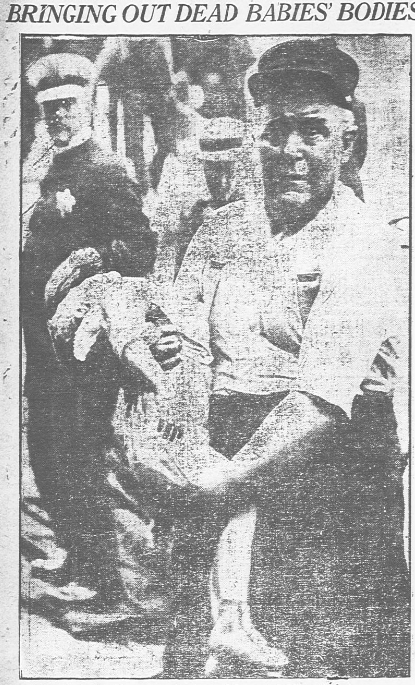
Survivor Telling How It Happened
Mrs. Joseph Kostacki, a survivor, said:
“We were all making our way to the upper deck and a great many went to the side of the boat toward the dock. Still a greater number, however, went over to the river side. All of a sudden, just as the boat seemed pulling out from the dock she began to list and slowly teetered over away from the dock.
“Hundreds rushed toward the dock side and many jumped overboard. Women and children became frantic. Nobody seemed to know what to do. Few thought of life preservers. There was little time to think about anything.
“Shortly the air was filled with screams of horror. Hundreds slipped over the side of the boat into the water. We were among those who were lucky enough to be saved. We hung on until rescued.” [Source]
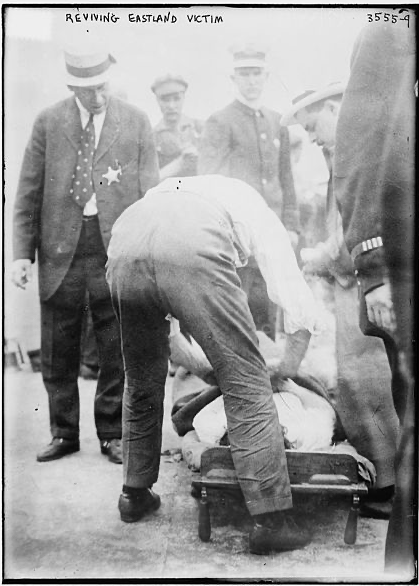
How So Many People Died
What Mrs. Kostacki doesn’t explain was how it came to be that so many people died. One newspaper explained it best. When the Eastland started to tip:
“…a mad rush of 2,000 people attempted to get off the boat. In a moment the river was so filled that people were jumping right down on top of one another. In spots people were two and three deep beneath the water, the bottom ones struggling vainly to get up until they died, often dragging with them the more fortunate ones on top.
“There was not room to swim. Those who could not tread water simply had to sink.
“Because of the jam of people in the water, rescue work was difficult. The boats could only reach the outer fringe. Those in the center who were strong enough to stick up took their turn in being saved.
“At least 500 were caught inside the boat. Many of these were women with babies who had retired to staterooms. Few of these were saved. Those not drowned, it is claimed, were suffocated with steam.
“…[on deck] women and children were beaten to death by the maddened crowd before they had a chance to leave the deck.”
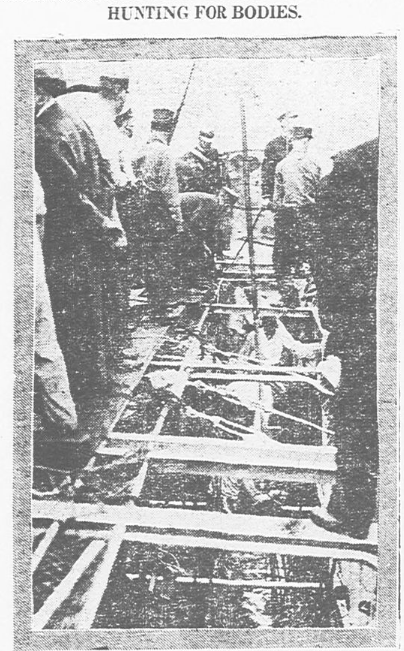
Witness Dropping Babies
Robert Satterfield, a witness to the Eastland Disaster, wrote:
“Women near the gates [on the Eastland] tried to toss babies and children to the outstretched hands on the pier. Some were caught and others dropped into the water between the boat and the slimy piling and sucked under and drowned.
“[After the boat had turned over] life preservers were rained into the river by the wagonload. Everybody that could grab something that would float threw it to the struggling mass of victims.
“Choking in the muddy water, the victims were drawn under and carried down the river by the current faster than they could be pulled into the fleet of lifeboats and tugs that now were arriving on the scene.
“I saw women with babies in their arms being swept away under the Fifth Avenue bridge, a short distance away.
“One woman reached for a grappling hook thrust to her from a rowboat. She missed it.
“The river literally was black with victims and the boats and barges that had gone to their rescue.
“Meanwhile police and firemen had leaned onto the slippery side of the boat that now stuck up from the river. Firemen with ropes tied to their waists were lowered through the portholes that now gaped to the sky.
“The first victims they could reach were hoisted up by ropes. Girl after girl was hauled up, their soaked holiday attire standing out in pitiful contrast against the scene of death.
“With a last effort, [one woman] jerked up in the water and tried to toss her little girl to [the rescuers]. The effort plunged the mother down under the surface again and she did not reappear. But the child fell a yard nearer the boat.
“Its white, holiday dress with its ribbons spread out kept her afloat. Then the grappling hook caught it and she was dragged onto the boat.” [Source]
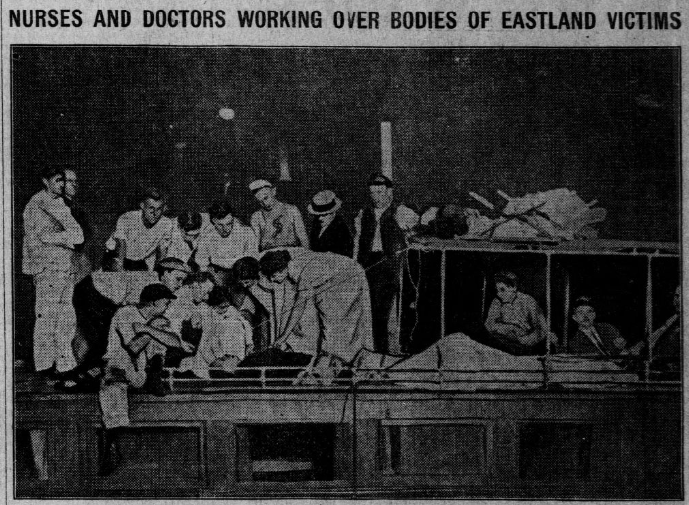
Vantak Survivor
Henry Vantak was on the Eastland with his wife and three children. Henry survived the ordeal, but he lost his entire family to the waters. He wrote:
“I could not believe the boat was turning over. About a dozen of [the people] on the upper decks jumped. The rest were thrown into the river.
“I did not see my wife or children after the boat turned. They were carried into the river with the crowd. Some one grabbed me around the neck and kept pulling me. It was a woman, but I could not save her.
“I saw dozens of people drown around me, but was unable to give assistance. By a great effort I was able to climb on the upper side of the boat and managed to hold on until taken off by rescuers.” [Source]
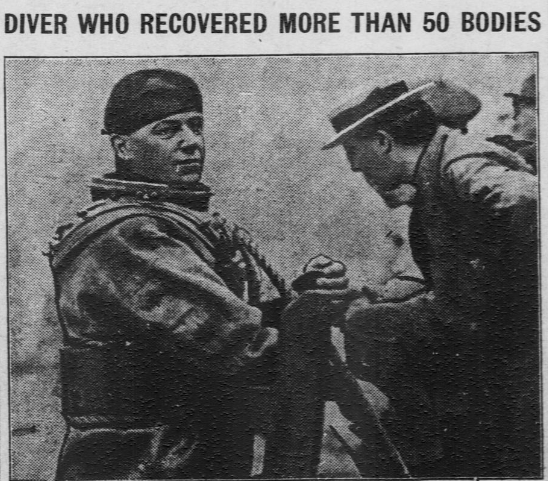
Thoyer Survivor
Mrs. H.A. Thoyer lost her husband and eight-year-old daughter to the waters. She said:
“My husband and I and the children were standing together on the deck and all fell into the water in a heap. I am a good swimmer. I caught hold of my son Harry, and my little girl Helen, and clung to them and kept myself up some way, I don’t know how. I saw men and women tumbling into the water around me. My husband disappeared among them. I had Harry with my right arm and Helen with my left. I seemed to lose all strength in my left arm and I had to let go of Helen. She went down in the struggling mass. Then some one – a man with a uniform on – grabbed me and began swimming with me. I clung to my son and when swept near the river bank some men pulled us up.” [Source]
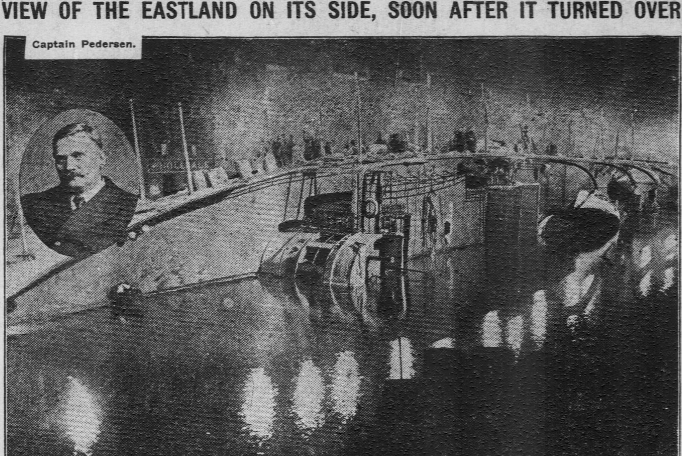
Young Rescuer
There were also reports of a young man “who jumped off the docks at LaSalle street six times and rescued six women. The seventh time he was either overcome by cramps or was too exhausted to swim any further. He disappeared in the water.” [Source]
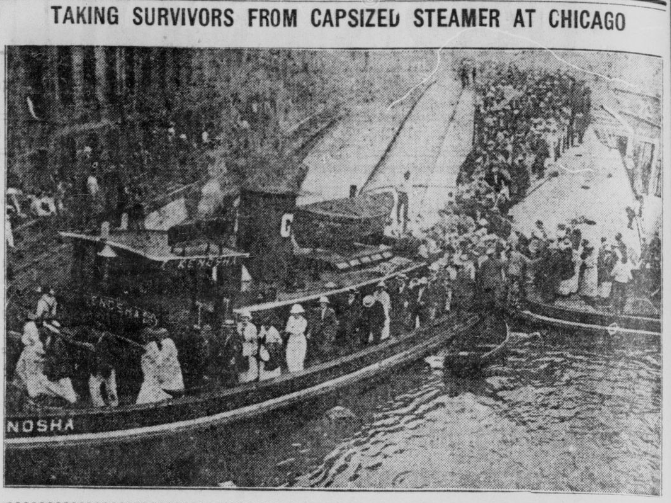
Families on Dock and Shore Afterwards
On the shore, mothers were yelling the names of their children who were on the Eastland. Men surrounded the policemen and demanded to know whether or not their entire families had been wiped out.
One report stated:
“Scenes around the dock shortly after the accident happened were terrible. Women and children were yelling frantically for their relatives. Men were crying like babies. Several families had been separated in the mad scramble for safety when the boat first listed. Part of the family went down and the other part was rescued.
“Thousands of people soon lined the docks. Among the first rescued were women, men, and children who had hung onto the boat until a rescue tug steamed to the scene.
“All over the ground lay people who had been rendered unconscious in the water. As they were rescued they were carried to the dock and left for doctors to work over. The work of rescue of those still on board the boat and those who were in the water hanging onto wreckage were sensational.” [Source]
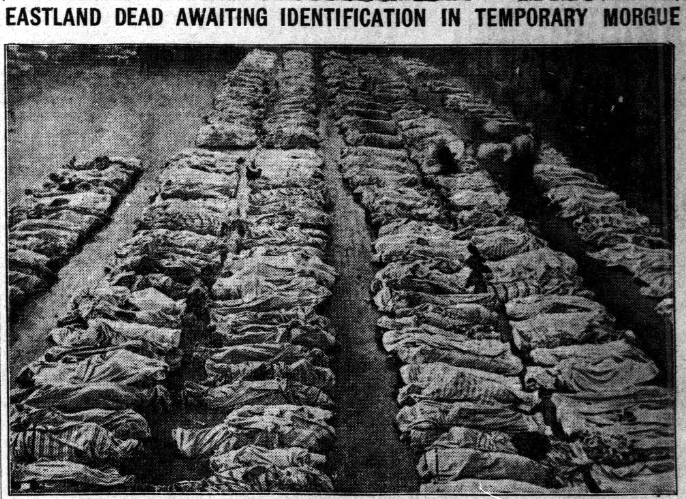
The Dead
As the dead were removed from the water, they were taken to temporary morgues. The Evening World reported that:
“Temporary morgues were established, and every sort of a vehicle available was pressed into service for hauling the bodies of the dead. Many bodies were carried for blocks down the stream and were dragged to wharves and bridges. Rescuers at work on the Eastland said that the victims were packed on the under side of the boat like sardines in a can.
“Three hours after the accident the cries and poundings of persons confined in cabins and other rooms above the water line were audible to persons on shore above the rattle of drills and other apparatus with which holes were being cut through the steel framework.
“When it was learned that bodies were being found down the river, orders were issued to the great pumping stations which force water from Lake Michigan into the Chicago River and down to the Drainage Canal to shut down. In a short time the artificial current ceased and the Chicago River became as stagnant as it was in the days when it was practically a navigable pond.” [Source]
“There was row upon row of bodies at a score of temporary morgues in first-floor offices throughout the neighborhood. And the pitiful thing was that for every body of a man there were three to five bodies of girls, children, and women. The stiffened arms of some of the women clutched their babies tightly.” [Source]
Mourning
On July 28, four days after the Eastland disaster, the city of Chicago went into mourning as the victims are laid to rest.
It was reported that:
“Auto trucks donated by business houses were used to carry bodies, as there were not enough hearses to go round. On 25th street, a huge truck passed. On the driver’s seat was a man in a silk hat, white gloves, and frock coat. Inside were three bodies – a family. On 48th avenue, a hay rack draped with crepe and driven by a silk hatted man, passed. It contained two bodies.” [Source]


I presume that the underlying cause of the disaster was that the Eastland was overloaded with too many passengers?
That was the assumption. The Eastland was too top heavy and just rolled over.